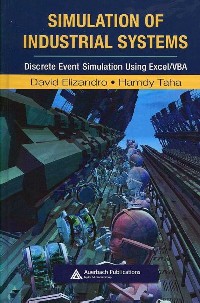简介
Elizandro (industrial engineering, Tennessee Tech U.) and Taha (industrial engineering, U. of Arkansas) have provided a hands-on tutorial on how to model traditional applications to optimize production operations. The volume is intended for novices who wish to learn the basics of discrete event simulation and as a reference for professionals who wish to perform system modeling. Divided into three parts, the book first presents concepts of discrete simulation. The second section explores the functions and uses of Design Environment for Event-Driven Simulation (DEEDS), which is an Excel/Virtual Basic for Applications add-in. The third section offers a variety of applications using DEEDS. Chapters conclude with references and problems intended to reinforce the topic. A CD-ROM is included. The volume is distributed by Taylor & Francis. Annotation 漏2008 Book News, Inc., Portland, OR (booknews.com)
目录
Table of Contents
CONTENTS
PREFACE
Part I SIMULATION FUNDAMENTALS
1 SIMULATION MODELING
1.1 Why Simulate
1.2 Types of Simulation
1.3 The Simulation Clock
1.4 Randomness in Simulation
1.5 Discrete Simulation Languages
1.6 Design Environment for Event Driven Simulation (DEEDS)
1.7 The Two Sides of Simulation
1.8 Organization of this Book
Selected References
Problems
2 PROBABILITYAND STATISTICS IN SIMULATION
2.1 Role of Probability and Statistics in Simulation
2.2 Characterization of Common Distributions in Simulation
2.2.1 Properties of Common Distributions
2.2.2 Identifying Distributions Based on Historical Data
2.3 Statistical Output Analysis
2.3.1 Confidence Intervals
2.3.2 Hypothesis Testing
2.4 Summary
Selected References
Problems
3 ELEMENTS OF DISCRETE SIMULATION
3.1 Concept of Events in Simulation
3.2 Common Simulation Approaches
3.2.1 Event Scheduling Approach
3.2.2 Activity Scanning Approach
3.2.3 Process Simulation Approach
3.3 Computations of Random Deviates
3.3.1 Inverse Method
3.3.2 Convolution Method
3.3.3 Acceptance-Rejection Method
3.3.4 Other Sampling Methods
3.3.5 Generation of (0,1) Random Numbers
3.4 Collecting Data in Simulation
3.4.1 Types of Statistical Variables
3.4.2 Histograms
3.4.3 Queue and Facility Statistics in Simulation
3.5 Summary
Selected References
Problems
4 GATHERING STATISTICAL OBSERVATIONS IN SIMULATION
4.1 Introduction
4.2 Peculiarities of the Simulation Experiment
4.2.1 Issues of Independence
4.2.2 Issue of Stationarity (Transient and Steady State Conditions)
4.2.3 Issue of Normality
4.3 Accounting for the Peculiarities of the Simulation Experiment
4.3.1 Normality and Independence
4.3.2 Effect of Transient Conditions
4.4 Methods of Gathering Simulation Observations
4.4.1 Subinterval Method
4.4.2 Replication Method
4.4.3 Regenerative Method
4.5 Variance Reduction Technique
4.6 Summary
Selected References
Problems
5 OVERVIEW OF DEEDS
5.1 Introduction
5.2 Modeling Philosophy
5.3 Basic Elements
5.4 Basic Features
5.5 Develop and Execute a Model
5.6 Summary
6 NETWORK REPRESENTATION
6.1 Components of the Model
6.1.1 Nodes
6.1.2 Transactions
6.1.3 Lists
6.1.4 Classes and Procedures
6.1.5 Simulation Program
6.2 Program Initial Conditions
6.3 Summary
Problems
Part II Excel/VBA and Design Environment for Discrete Event Simulation
7 VBA
7.1 Introduction
7.2 Visual Basic Names
7.3 VBA Data Types
7.4 Variable Definitions
7.5 Constants
7.6 Expressions
7.7 Assignment Statements
7.8 Control Structures
7.9 Procedures
7.9.1 Subs
7.9.2 Functions
7.10 Arrays
7.11 Summary
Selected References
Problems
8 USER INTERFACE
8.1 Introduction
8.2 Overview of Program Manager
8.3 Source Nodes
8.4 Queue Nodes
8.5 Facility Nodes
8.6 Initial Model
8.6.1 Build VBA Code
8.6.2 Program Execution
8.6.3 Viewing Options
8.7 Delay Nodes
8.8 Statistical Variables
8.9 User Defined Probability Distribution Functions
8.10 User Defined Tables
8.11 Program Execution Expanded
8.12 Summary
Problems
9 MODELING PROCEDURES
9.1 Introduction
9.2 VlBA Procedures
9.3 Simulator Procedures
9.4 DEEDS Classes
9.4.1 Source
9.4.2 Queue
9.4.3 Facility
9.4.4 Delay
9.4.5 Transaction
9.4.6 Statistic
9.4.7 PDF
9.4.8 Table
9.5 Distribution Functions
9.6 Visual Basic Functions
9.7 Excel WorkSheetFunctions
9.8 Summary
Problems
10 SIMULATION OUTPUT
10.1 Introduction
10.2 Gathering Observations
10.3 Simulation Messages
10.4 Monitoring Simulation During Execution
10.5 Forced Model Termination
10.6 Standard Output
10.7 Model Verification
10.7.1 User Defined Simulator Messages
10.7.2 Trace Report
10.7.3 Collection Report
10.8 Interactive Debugger
10.9 Summary
Selected References
Problems
11 ANALYSIS OF SIMULATION RESULTS
11.1 Introduction
11.2 Effect of Transient State
11.3 Gathering Statistical Observations
11.4 Establish Confidence Intervals
11.5 Hypothesis Testing in Simulation Experiments
11.6 Summary
12 MODELING SPECIAL EFFECTS
12.1 Introduction
12.2 A Multi-server Facility to Represent Independent Facilities
12.3 Facility Preemption Operation
12.4 Limit on Waiting Time in Queues
12.5 Time-Dependent Inter-Creation Time at a Source
12.6 Network Logic Change Using Queue Nodes
12.7 Controlled Blockage of a Facility
12.8 Assemble and Match Sets with Common Queues
12.9 Jackson Networks
12.10 Sampling Without Replacement
12.11 Summary
13 ADVANCED ROUTING TECHNIQUES
13.1 Introduction
13.2 Routing Transactions
13.2.1 Always Routing
13.2.2 Conditional Routing
13.2.3 Select Routing
13.2.4 Dependent Routing
13.2.5 Exclusive Routing
13.2.6 Last Choice
13.3 Synchronized Queues
13.4 Assemble Transactions
13.5 Summary
Selected References
Problems
Part III APPLICATIONS
14. MODEL DESIGN AND DEVELOPMENT
14.1 Introduction
14.2 System Specification
14.3 Simulation Constants, Decision Variables, and Constraints
14.4 Data Specifications
14.5 Project Management
14.6 Summary
15. FACILITIES LAYOUT MODELS
15.1 Introduction
15.2 Facilities Management
15.3 Line Balancing Model
15.4 AGVS and Flexible Manufacturing
15.4 Summary
16 MATERIAL HANDLING MODELS
16.1 Introduction
16.2 Transporter Car
16.3 Overhead Crane
16.4 Carousel Conveyor
16.5 Belt Conveyor Plywood Mill Operation
16.7 Summary
17 INVENTORY CONTROL MODELS
17.1 Introduction
17.2 Discount Store Model
17.3 Periodic Review Model
17.4 Continuous Review Model
17.5 Summary
18 SCHEDULING MODELS
18.1 Introduction
18.2 Job Shop Scheduling
18.3 PERT Project Scheduling
18.4 Daily Manpower Allocation
18.5 Summary
19 MAINTENANCE MODELS
19.1 Introduction
19.2 General Reliability Model
19.3 Maintenance Planning Model
19.4 Summary
20 QUALITY CONTROL MODELS
20.1 Introduction
20.2 Inspection Process Model
20.3 Control Chart Model
20.4 Summary
21 SUPPLY CHAIN LOGISTICS MODELS
21.1 Introduction
21.2 Port Operation Model
21.3 Automatic Warehouse Operation
21.4 Cross Dock Model
21.5 Summary
22. ANALYSIS OF LARGE SCALE MODELS
22.1 Introduction
22.2 Evaluation of Alternatives
22.3 Design of Experiments
22.4 Genetic Algorithms
22.5 Summary
Appendix A: DEEDS AddIn Installation
Appendix B: DEEDS Procedures
Appendix C: Histograms with Excel
- 名称
- 类型
- 大小
联系方式: 020-38250260 客服QQ:4006604884
云图客服:
用户发送的提问,这种方式就需要有位在线客服来回答用户的问题,这种 就属于对话式的,问题是这种提问是否需要用户登录才能提问
Video Player
×
Audio Player
×
pdf Player
×
亲爱的云图用户,
光盘内的文件都可以直接点击浏览哦
无需下载,可直接在线浏览


